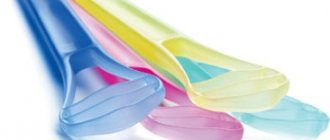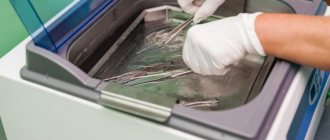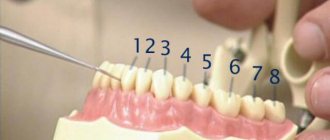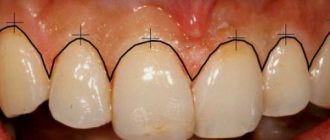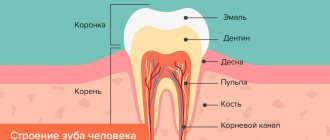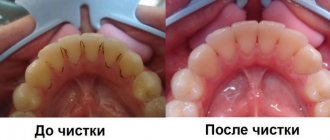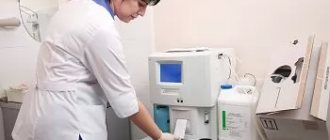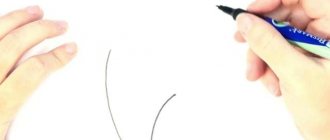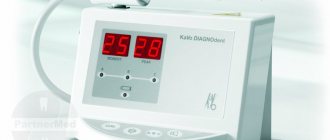Hygienic index
The Green-Vermilion hygienic index allows you to evaluate the amount of tartar and plaque separately. To determine it, six teeth are studied: 31, 11, 16, 26 - vestibular planes, and 36, 46 - lingual. Plaque can be assessed using dye solutions (Fuchsin, Schiller-Pisarev, Erythrosin) or visually.
The following codes and criteria for dental plaque exist:
- 0 – no layers;
- 1 - soft plaque covering no more than 1/3 of the tooth plane, or the presence of any number of colored deposits (brown, green and others).
- 2 – thin layer located on less than 2/3, but more than 1/3 of the surface of the molar;
- 3 – soft plaque, occupying more than 2/3 of the tooth plane.
Determination of sub- and supragingival molar stone is carried out using a dental probe.
What else is good about the Green-Vermilion index? Assessment of dental calculus (criteria and codes) is as follows:
- 0 – no stones present;
- 1 – supragingival deposit covering no more than 1/3 of the tooth plane;
- 2 – formation located above the gum, covering less than 2/3, but more than 1/3 of the plane of the tooth, or the presence of individual growths in its cervical region;
- 3 – supragingival layer covering more than 2/3 of the tooth plane, or large deposits of stone located near its neck.
The Green-Vermilion index is calculated by adding the values produced for each of its elements, dividing by the number of planes studied and adding both values.
Methods for assessing the hygienic state of the oral cavity
Topic: differentiated approach to the selection of means and methods of individual oral hygiene.
Hygienic condition of the oral cavity
can be assessed taking into account either the area occupied by plaque or its thickness.
Green-Vermillion index
(Green, Vermillion, 1964) - the simplified oral hygiene index (OHI-S), consists of assessing the area of the tooth surface covered with plaque and/or tartar, and does not require the use of special dyes.
Using a probe, index teeth are examined: buccal surface 16, 26, lingual surface 36 and 46 and labial surface 11, 31. The probe is moved from the cutting edge to the gum.
Criteria for evaluation
.
| Number of points | Plaque | Tartar |
| 0 | absent | absent |
| 1 | soft plaque covers up to 1/3 of the crown and/or any amount of dense pigment plaque | supragingival calculus up to 1/3 of the crown |
| 2 | plaque covers from 1/3 to 2/3 of the surface | supragingival calculus from 1/3 to 2/3 of the crown and/or subgingival calculus in the form of individual lumps |
| 3 | soft plaque covers more than 2/3 of the surface | supragingival tartar more than 2/3 of the crown and/or subgingival tartar circumferentially covers the neck of the tooth |
Index interpretation
(plaque index + stone index): OHI − S = (OHI − D)/6 + (OHI − C)/6.
results
:
- 0–0.6 points – low, good hygiene;
- 0.7–1.6 points - average, satisfactory;
- 1.7–2.5 points – high, unsatisfactory;
- 2.6 points or more - very high, bad.
Hygiene Performance Index
(Podschadley, Haley, 1968) - the area occupied by dental plaque is estimated. To register it, the oral cavity is rinsed with a solution of any dye.
The same teeth and the same surfaces are examined as in the OHI-S index. The examined tooth surface is divided into 5 sections. Segments:
- 1 - medial;
- 2 - distal;
- 3 - mid-cervical;
- 4 - central;
- 5 - mid-occlusal.
Assessment of each site
carried out according to the system: no staining - 0 points; yes - 1 point.
Tooth assessment
equal to the sum of the segment points (maximum 5).
PHP teeth = ∑ segment points. PHPindiv = (∑ teeth points) / n teeth.
results
:
- 0 points – excellent hygiene;
- 0.1 – 0.6 points – good;
- 0.7 - 1.6 points - satisfactory;
- 1.7 points or more - unsatisfactory.
Silnes-Lowe Hygiene Index
(Silness, Loe, 1964) is used to determine the thickness of dental plaque. 11, 16, 24, 31, 36, 44 are examined; all teeth can be examined or at the request of the researcher. 4 tooth surfaces are examined: vestibular, oral, distal, medial; at the same time, plaque is detected in the gingival area.
The presence of plaque is determined visually or using a probe without staining. After drying the enamel, the tip of the probe is passed along its surface at the gingival sulcus.
Criteria for evaluation
:
- 0 points - there is no plaque in the gingival area (it does not stick to the tip of the probe);
- 1 point - the plaque film in the gingival area is determined only by the probe, a soft substance adheres to its tip, the plaque is not visually detected;
- 2 points - plaque is visible to the naked eye in the gingival groove and in the subgingival area of the tooth crown. The layer is thin to moderate.
- 3 points - excess plaque on most of the tooth surface, intensive deposition of plaque in the area of the gingival sulcus and interdental spaces.
Index calculation for one tooth
: PLIteeth = (∑ points of 4 surfaces) / 4.
Calculation of the index for a group of teeth
: PLIindividual = (∑ teeth) / n teeth.
It is used in epidemiological surveys and to identify risk factors for the development of caries in a patient.
Next: toothbrushes, floss and other oral hygiene products.
Cliche
The calculation formula is attached as follows:
IGR-u = sum of plaque values/number of planes + sum of stone values/number of surfaces.
The interpretation of the index (the IGR value at the level of medicine) is proposed as follows:
- 0.0-1.2 - flawless;
- 1.3-3.0 – acceptable;
- 3.1-6.0 – low.
The Green-Vermilion index has the following values for dental plaque standards:
- 0.0-0.6 – impeccable;
- 0.7-1.8 – tolerable;
- 1.9-3.0 – bad.
KPU indices
What do oral hygiene indices express? One of the basic dental coefficients (BDC) demonstrates the intensity of decay. The letter “K” means the number of damaged teeth, “P” - the number of filled teeth, “U” - the number of teeth to be removed or liquidated. The sum of these values gives an idea of the development of the decay process in a particular person.
There are three types of KPU coefficient:
- KPUz – the number of carious and treated teeth in the subject;
- KPU of planes (KPUpov) – the number of destroyed faces;
- KPUpol – the sum of fillings and carious cavities.
For non-permanent teeth, the following indicators are used:
- KP – the number of damaged and healed teeth of short-term occlusion;
- KP – sum of rotten planes;
- CPR – number of carious cavities and fillings.
Teeth lost as a result of physical change or extracted are not taken into account in an unstable dentition. In children, when changing teeth, two coefficients are used simultaneously: KPU and KP. To identify the overall intensity of the disease, both degrees are summed up. KPI from 6 to 10 confirms a high intensity of decay, 3-5 – moderate, 1-2 – low.
These standards do not show the real picture, as they have the following shortcomings:
- both extracted and cured teeth are taken into account;
- can only increase over time and begin to reproduce past carious damage with age;
- do not allow for initial damage to be taken into account.
Periodontal index, its role in determining the patient’s status
In young people under the age of 19, only 6 teeth are examined: 16, 11, 26, 36, 31, 46. This modification of the technique was made in order to avoid classifying deep periodontal crevices associated with eruption as periodontal pockets. For the same reason, when examining children under 15 years of age, pocket registration is not carried out at all, i.e. Only bleeding gums and the presence of stone are taken into account. If there is no index tooth in the sextant to be examined, individual fully erupted incisors or premolars may serve as replacements. To determine the depth of the pockets, the presence of subgingival calculus and bleeding gums, probing of the index teeth is performed. The probing force should not exceed 20 g. A practical test to determine this force is to place the tip of the probe under the thumbnail and apply pressure until whiteness appears. To sense subgingival calculus, it is necessary to apply the least possible force, which will allow the spherical tip of the probe to move along the surface of the tooth. The tip of the inserted probe should be moved according to the anatomical configuration of the root surface. The appearance of pain during probing indicates the use of too much force. When determining the depth of the gum pocket, the tip of the probe should be inserted carefully, the immersion depth corresponds to the colored marks. The total length of the pocket is examined, for which the depth is determined at at least 6 points of each tooth: mesial-buccal, mid-buccal, distal-buccal, medial-lingual, mid-lingual, distal-lingual. Inspection and data recording. Probing is carried out on index teeth of the appropriate age.
Rating scale: 4 - pocket more than 6 mm; 3 - pocket 3.5 - 5.5 mm; 2 – there is no periodontal pocket, but there is inflammation of the gums, tartar, defects in fillings or crowns; 1 - bleeding immediately after the end of probing, observed directly with the eye or with the help of a mirror, no tartar, no pockets; 0 – periodontium is intact.
Evaluation of results. The need for treatment is assessed: 0 - no treatment required; 1 - oral hygiene; 2 — removal of dental plaque + hygiene; 3 — removal of deposits + conservative therapy + curettage + hygiene; 4 - removal of deposits + conservative therapy + patch surgery + orthopedic treatment + hygiene.
Serious shortcomings
Significant flaws in the indicators of KPUz and KPUpov include their uncertainty with increasing decay due to the formation of new depressions in healed teeth, loss of fillings, the occurrence of secondary caries and similar factors.
The multiplicity of caries is shown as a percentage. To do this, the composition of people in whom this disease was found (except for focal demineralization) is divided by the number of those studied in this team and multiplied by one hundred.
In order to assess the prevalence of tooth decay in a particular region, the following estimated conditions for the level of prevalence among twelve-year-old children are used:
- low intensity level – 0-30%;
- relative – 31-80%
- large – 81-100%.
Types of KPU index
KPU is considered the main indicator in dentistry. It reveals how intense the caries process is. It is used to analyze both temporary and permanent teeth.
Basic data:
- K – number of caries foci;
- P – number of fillings placed;
- Y is the number of units that were removed.
The total expression of these data provides information about the intensity with which caries is developing in the patient.
KPU classification:
- KPU of teeth - the number of caries-affected and filled units in the patient;
- KPU of surfaces – the number of enamel surfaces infected with caries;
- KPU of cavities - the number of cavities from caries and fillings.
For milk teeth, kp indicators are used, where k is caries lesions, p is filled. In this case, units that were removed or dropped out are not taken into account. If there are two types of teeth, both indicators KP and KPU are used, and the infection of all teeth is taken into account.
CPITN Index
The hygienic state of the oral cavity is assessed using different indices. Let's consider the CPITN coefficient. It is used in clinical practice to monitor and examine periodontal health. Using this index, only those signs that can begin to develop in the opposite direction are recorded (tartar, gum inflammation, which is judged by bleeding), and does not take into account irreversible changes (tooth mobility, gum recession, loss of epithelial attachment).
CPITN does not record process activity. This coefficient is not used for treatment planning. Its most important advantage is the speed of identification, information content, simplicity and the ability to compare results. The need for treatment is determined based on the following signs:
- code X or 0 means that there is no need to treat the patient;
- 1 indicates that a person should take better care of his or her mouth;
- 2 means that it is necessary to eliminate the factors influencing the retention of plaque and carry out professional hygiene;
- Code 3 indicates constant oral hygiene and curettage, which usually reduces inflammation and reduces pocket depth to less than or equal to 3 mm;
- 4 means that adequate hygiene of the oral mucosa is necessary, as well as deep curettage. In this case, combined treatment is required.
Index of need for periodontal disease treatment - CPITN
To assess the prevalence and intensity of periodontal diseases, almost all countries use the index of need for the treatment of periodontal diseases - CPITN . This index was proposed by specialists of the WHO working group to assess the condition of periodontal tissues during epidemiological surveys of the population.
Currently, the scope of the index has expanded, and it is used to plan and evaluate the effectiveness of prevention programs, as well as calculate the required number of dental personnel. In addition, the CPITN index is currently used in clinical practice to examine and monitor the periodontal condition of individual patients.
In this regard, the CPITN index can be considered a screening test at both the population and individual levels.
This index registers only those clinical signs that may undergo reverse development: inflammatory changes in the gums, which are judged by bleeding, tartar. The index does not record irreversible changes (gingival recession, tooth mobility, loss of epithelial attachment), does not indicate the activity of the process and cannot be used to plan specific clinical treatment in patients with developed periodontitis.
The main advantages of the CPITN index are the simplicity and speed of its determination, information content and the ability to compare results.
To determine the CPITN index, the dentition is conventionally divided into 6 parts (sextants), including the following teeth: 17/16, 11, 26/27, 36/37, 31, 46/47.
The periodontium is examined in each sextant, and for epidemiological purposes only in the area of the so-called “index” teeth. When using the index for clinical practice, the periodontium is examined in the area of all teeth and the most severe lesion is identified.
It should be remembered that a sextant is examined if it contains two or more teeth that cannot be removed. If only one tooth remains in the sextant, it is included in the adjacent sextant, and this sextant is excluded from the examination.
In the adult population, starting from 20 years of age and older, 10 index teeth are examined, which are identified as the most informative:
When examining each pair of molars, only one code characterizing the worst condition is taken into account and recorded.
For persons under 20 years of age, 6 index teeth are examined during the epidemiological survey: 16, 11, 26, 36, 31, 46.
CODE 1: bleeding observed during or after probing.
Note: bleeding may appear immediately or after 10-30 seconds. after probing.
CODE 2: tartar or other plaque-retaining factors (overhanging edges of fillings, etc.) are visible or felt during probing.
CODE 3: pathological pocket 4 or 5 mm (the edge of the gum is in the black area of the probe or the 3.5 mm mark is hidden).
CODE 4: pathological pocket 6 mm deep or more (with the 5.5 mm mark or black area of the probe hidden in the pocket).
CODE X: When only one or no teeth are present in the sextant (third molars are excluded unless they are in place of second molars).
To determine the need for periodontal disease treatment, population groups or individual patients can be categorized based on the following criteria.
0: CODE 0 (healthy) or X (excluded) for all 6 sextants means that there is no need for treatment for this patient.
1: A CODE of 1 or higher indicates that this patient needs to improve his oral hygiene status.
2: a) CODE 2 or higher indicates the need for professional hygiene and the elimination of factors that contribute to plaque retention. In addition, the patient needs training in oral hygiene.
b) CODE 3 indicates the need for oral hygiene and curettage, which usually reduces inflammation and reduces pocket depth to values equal to or less than 3 mm.
3: Sextant with CODE 4 can sometimes be successfully treated with deep curettage and adequate oral hygiene. In other cases, this treatment does not help, and then complex treatment is required, which includes deep curettage.
The prevalence and intensity of periodontal disease in the population is assessed based on the results of a survey of 15-year-old adolescents.
Prevalence of signs of periodontal damage (adolescents 15 years old)
Prevalence Bleeding gums Tartar
low 0 – 50% 0 – 20%
average 51 – 80% 21 – 50%
high 81 – 100% 51 – 100%
Level of intensity of signs of periodontal damage (adolescents 15 years old)
INTENSITY LEVEL BLEEDING GUMS CALCULUS
LOW 0.0 - 0.5 sextants 0.0 - 1.5 sextants
AVERAGE 0.6 - 1.5 sextants 1.6 - 2.5 sextants
HIGH < 1.6 sextants < 2.6 sextants
Children's hygiene
What is the Fedorov-Volodkina index? It can be used to determine whether the patient takes good care of his teeth. This indicator should be used to assess the oral health of children under 5-6 years of age. To establish it, the labial edge of six teeth is studied.
Using special solutions, teeth are stained and the presence of plaque on them is assessed. Determination of sub- and supragingival calculus is carried out using a dental probe. The calculation of the coefficient consists of the numbers obtained for each of its elements, divided by the number of planes studied, followed by the addition of both values.
Oral Hygiene Performance Index (OHP)
LESSON No. 6,7
TOPIC: Determination of the hygienic state of the oral cavity, methods for identifying dental plaque. Hygiene indices.
GOAL: To train students in the methods of determining IGR-U, the Fedorov-Volodkina index, the RNR index, and the index for assessing dental plaque in young children.
TASKS:
- Master the technique of determining the hygienic condition of the oral cavity.
- Teach methods for identifying dental plaque.
STRUCTURE OF THE PRACTICAL LESSON
| STEPS | Equipment, technical means | Tutorials | Time |
| 1. Demonstration of the methodology for determining the IGR-U index, Fedorov-Volodkina index, and RNR index on a volunteer student. | Dental unit, set of dental instruments | Table IGR-U, scheme for determining IGR-U, RNR | 30 min |
| 2. Individual training of students in the methodology for determining the Fedorov-Volodina index and determination of the index by students | 30 min | ||
| 3. Individual training of students in the methodology for determining the PHP index and determination of the index by students | 30 min | ||
| 4. Individual training of students in the methodology for determining the IGR-U index and determination of the index by students | 30 min | ||
| 5. Individual knowledge control | 10 min | ||
| 6. Homework | Guidelines | 10 min |
Questions previously studied and necessary for mastering this topic.
- Composition and properties of the cuticle.
- Composition and properties of dental plaque.
- Composition and properties of pellicle.
Test questions to determine background knowledge.
- Methodology for determining the IGR-U index.
- Interpretation of IGR-U values.
- Formula for calculating IGR-U values.
- Methodology for determining the Fedorov-Volodkina index.
- Interpretation of the Fedorov-Volodkina index values.
- Methodology for determining the PNR index.
- Interpretation of PNR values.
- Formula for calculating PNR values.
- Methodology for determining the index for assessing dental plaque in young children.
- Interpretation of index values for assessing dental plaque in young children.
- Formula for calculating index values for assessing dental plaque in young children.
Expected responses:
The dentition is divided into 6 sectors (sextants) for examination and the teeth from each sextant are studied.
| 18 — 14 | 13 — 23 | 24 — 28 |
| 48 — 44 | 43 — 33 | 34 — 38 |
Two front sextants: upper, lower and 4 side sextants: right upper and lower and left upper and lower.
The most convenient way to assess oral hygiene is to count the surface of the tooth covered with dental plaque.
Green-Vermillion index OHI-S (1964) or simplified oral hygiene index IGR-U.
FORMULA: GAME-U= + ,
Where:
ZN - dental plaque,
ZK - tartar,
n is the number of teeth examined (almost always 6).
Methodology:
Visually, using an angular probe, the plaque and plaque are determined on the labial surfaces 11 and Z 1, buccal surfaces 16 and 26, lingual surfaces 36 and 46. For a more accurate determination of dental plaque, it is stained with Lugol’s solutions
| signs | designations | signs | designations |
| ZN not detected | ZK not detected | ||
| soft plaque covers 1/3 of the tooth and/or dense brown plaque any amount | The supragingival zone covers 1/3 of the tooth surface | ||
| Soft ZN covers 2/3 of the tooth surface | The supragingival zone covers 2/3 of the surface and/or the subgingival zone in the form of separate conglomerates | ||
| Soft plaque covers more than 2/3 of the tooth surface | The supragingival zone covers more than 2/3 of the surface and/or the subgingival zone surrounding the cervical part of the tooth |
INTERPRETATION
| The meaning of IGR-U | IGR-U assessment | Oral hygiene assessment |
| 0 — 0,6 | Short | good |
| 0,7 – 1,6 | Average | Satisfactory |
| 1,7 – 2,5 | High | Unsatisfactory |
| 2.6 or more | Very tall | Bad |
Notes:
1.The index is calculated to hundredths and rounded to tenths.
1/6-0,2 2/6 = 0,3 3/6= 0,5 4/6=0,8
example: 16/6 = 12/6 + 4/6=2 +
0,7 = 2,7
12/6 - separate whole ones.
2. If there is no tooth to be examined, you can study the nearby one within the sextant according to the following scheme:
front sextant 11———21———12———22——— 13———23
31——- 41———32———42———33———43
side sextant 6———7——— 5———8———-4
3. If all the teeth in a sextant are missing, then this sextant is not taken into account and the index is determined by the teeth in the remaining sextants.
4. If there are crowns on the teeth, the adjacent teeth are examined in a sextant according to the above diagram. If all the teeth in the sextant have crowns, then plaque and tartar on the crown are examined.
The Fedorov-Volodkina hygienic index is recommended to be used to assess the hygienic condition of the oral cavity in children under 5-6 years of age. To determine the index, the labial surface of six teeth is examined: 83(43), 82(42), 81(41), 71(31), 72(32), 73(33). The indicated teeth are stained using special solutions (Schiller-Pisarev, fuchsin, erythrosine) and the presence of plaque is assessed using the following codes:
1. No plaque was detected.
2. Staining 1/4 of the tooth crown.
3. Coloring 1/2
tooth crowns.
4. Coloring 3/4
tooth crowns.
5. Staining the entire surface of the tooth.
To assess the plaque present in a given patient, add up the codes obtained from examining each of the stained teeth and divide the sum by 6.
| Index value | Hygiene level |
| 1,1-1,5 | Good |
| 1,6-2,0 | Satisfactory |
| 2,1-2,5 | Unsatisfactory |
| 2,6 — 3,4 | Bad |
| 3,5 — 5,0 | Very bad |
Evaluation criteria:
To obtain the average value of the hygiene index in a group of children, add up the individual index values for each child and divide the sum by the number of children in the group.
Oral Hygiene Performance Index (OHP).
To quantify dental plaque, 6 teeth are stained:
16,26,11,31 - vestibular surfaces;
36, 46 - lingual surfaces
In the absence of an index tooth, the neighboring one, within the group of teeth of the same name, is examined. Artificial crowns and parts of fixed dentures are examined in the same way as teeth.
The surface of each tooth is conventionally divided into 5 sections.
- Medial
- Distal
- Mid-occlusal
- Central
- Midcervical
Codes and criteria for assessing dental plaque
0 - no staining
1 - staining detected
Index calculation
A . The code of each tooth is determined by adding the codes for each section.
B. Sum up the codes for all examined teeth and divide the resulting sum by the number of teeth.
Sum of all teeth codes
RNR = Number of teeth examined
Interpretation
Norm
The Fedorov-Volodkina index (1968) is still used in our country today.
First, the labial surface of the six front lower teeth is stained with a potassium-iodine-iodide solution. The hygienic index is determined by the intensity of the resulting color, then it is assessed using the five-point method and calculated using the formula Kcp=(∑Ku)/n, where:
- Ksr – general hygienic cleaning coefficient;
- Ku – healthy indicator of cleaning one tooth;
- n – number of teeth.
Coloring the entire plane of the crown means 5 points; 3/4 – 4; 1/2 – 3; 1/4 – 2 points; lack of color – 1. Normally, a healthy indicator should not exceed 1.
KPU index assessment
Three main indicators are used to identify the degree of infection.
The extent of caries spread is assessed as a percentage. To do this, the number of patients with caries problems must be divided by the total number of people studied and multiplied by 100. To compare regions by level of dental health, an assessment of their health status in 12-year-old adolescents is used.
Prevalence of caries:
- up to 30% low;
- up to 80% average;
- up to 100% high.
The intensity of infection is determined based on the number of dental units damaged by caries.
There are 5 degrees based on the CPU indicator:
For children 12 years old
- less than 1.1 – very low;
- up to 2.6 - low;
- up to 4.4 - moderate;
- up to 6.4 - high;
- over 6.5 – very high.
In adults 35 years old
- less than 1.5 – very low;
- up to 6.2 - low;
- up to 12.7 - moderate;
- up to 16.2 - high
- over 16.3 – very high.
The increase in caries infection is determined in the same patient after a certain period of time. Changes in values during inspections constitute an increase. These studies provide an opportunity to study the level of health and prescribe an individual treatment plan for each patient.
Inspection
What are the indicators for assessing the results of medical examination by a dentist? It is known that a comprehensive examination of residents involves a method of protecting their health, consisting of providing conditions for their impeccable physical development, preventing illnesses through the implementation of proper sanitary, hygienic, preventive, therapeutic and social measures.
The purpose of medical examination is to strengthen and preserve people's health and increase their life length.
A medical examination is designed to solve the following problems:
- annual analysis of a person’s well-being;
- comprehensive monitoring of patients;
- combating bad habits, identifying and eliminating the causes of tooth decay;
- active and timely implementation of health-improving and therapeutic measures;
- increasing the efficiency and quality of medical care to the population through the successive and interconnected work of all types of institutions, large-scale participation of doctors of various professions, the introduction of technical support, new unifying forms, the creation of mechanical systems for examinations of the electorate with the development of special programs.
Stages of epidemiological survey following the WHO methodology
Epidemiology is a way of studying the nature of the spread of diseases in different segments of the population. It is also used for dental purposes.
Epidemiological survey consists of three main stages:
- Preparatory stage . A plan is drawn up indicating the timing, methods and objectives of the research. The research site and necessary equipment are being prepared. A group of two doctors and a trained nurse is formed. Special population groups are selected to characterize their populations and living conditions (climatic conditions, social conditions, environment, etc.). The number of male and female people should be the same. The size of the groups depends on the required level of rigor of the study.
- The second stage is examination . A registration card is used to record data. For children under 15 years old it has a simplified form. Additions and corrections to the map are prohibited. All entries are made in the form of codes indicating the specific manifestation of symptoms or their absence. To get a complete picture of the state of health, information is collected on the oral mucosa and the extraoral area.
- The third stage is evaluating the results . Data is calculated according to the required parameters - the level of caries prevalence, the level of periodontal disease, etc. The results are displayed as a percentage.
Such examinations make it possible to assess the dental situation in a particular region and to identify the dependence of the health of the oral mucosa on environmental and social living conditions. And also monitor changes in the condition of teeth and gums as the patient ages.
It is important to identify the most common diseases and their intensity in different regions and age groups. Based on the research results, preventive measures for the treatment of serious diseases and hygiene training are outlined.
Observation of children
By calculating the Green-Vermilion index, doctors can create dispensary groups for monitoring children:
- Group 1 – children who have no pathologies;
- Group 2 – actually healthy babies with a history of any chronic or acute disease that does not affect the function of the most important organs;
- Group 3 – children with chronic illnesses with a balanced, sub- and decompensated course.
There are three phases in the dental examination of children:
- In the first phase of the examination, each child is individually recorded, an additional examination is carried out in the hospital, then an outpatient observation group is determined, the endurance of each child is assessed and the order of examinations is determined.
- In the second, a contingent is formed according to supervision groups, uniform conditions for phasing and continuity of study are assigned, dispensary patients are proportionally divided between doctors, and the needs of the examined contingents in inpatient and outpatient treatment are met.
- In the third, doctors determine the frequency and nature of active supervision of each child, adjust diagnostic and treatment measures in accordance with changes in health status, and evaluate the effectiveness of supervision.
Of great importance is the organization of educational work to prevent dental diseases in children and create motivation to care for newly emerging teeth.
Examination of pregnant women
In order to achieve maximum effect in the prevention of dental diseases, it is necessary to coordinate the work of the dentist and gynecologist, as well as medical examination of women throughout pregnancy. In the dental office, doctors carry out:
- sanitation of the oral cavity;
- assistance in the selection of basic and additional hygiene products, training in rational oral care;
- professional hygiene;
- remineralizing therapy, which increases the resistance of tooth enamel.
Prevention of caries
Determining the Green-Vermilion index plays a vital role in the prevention of dental diseases in expectant mothers, which is designed to solve two problems: preventing the development of intrauterine caries in babies and improving the dental status of women.
It is known that the health of the mother affects the process of developing the child’s teeth, which begins at 6-7 weeks of pregnancy. Doctors have determined that with various pathologies in the fetus, the mineralization of tooth enamel slows down, and sometimes stops at the stage of primary calcification. In the postpartum period, it may resume, but will not reach the standard level.
In a woman, already in the early stages of pregnancy, the condition of hard dental tissues and periodontal tissues worsens due to the unsatisfactory hygienic condition of the oral cavity. That is why she must carry out preventive measures until the baby is born. Doctors advise women to adhere to the correct work and rest regime, take vitamin therapy and eat well.
What is the hygiene index in dentistry
In dentistry, health status is measured in the form of special indices.
The hygiene index is data that can be used to assess the hygienic state of the oral cavity. The degree of contamination of the enamel surface is assessed, and the presence of bacteria and stone, their quantitative expression, and the ratio of healthy and carious ones are identified. Thanks to these hygiene data, during periodic examinations, the doctor can identify the causes of tooth and gum decay, and also take preventive measures to prevent many serious diseases of the oral mucosa.
Using hygiene data, the dentist finds out:
- oral health;
- stage of destruction;
- deleted units and those that cannot be recovered;
- how thoroughly the cleaning is carried out;
- stage of tissue destruction;
- curvature in bite;
- assessment of treatment effectiveness.
The dentist observes this and many other useful information about the health of the mucous membrane thanks to hygiene indicators. For the analysis of each type of destruction and damage to teeth and tissues, there is its own specialized data.
Tartar
The tooth surface is sensitive to various influences. Stones form on it due to the following reasons:
- violation of the chewing process;
- habit of snacking and consumption of an impressive amount of carbonated drinks and carbohydrates;
- eating mostly soft foods;
- diseases of internal organs;
- smoking and alcohol abuse.
The composition of supra- and subgingival stones is somewhat different from each other. The first is dominated by calcium carbonate, magnesium and calcium phosphate. In addition, it is very hard. The second is formed from dental plaque, which contains a large amount of food debris, epithelial cells, mucus, bacteria, bound by viscous saliva.
Why do you need to clean your mouth? It helps prevent the formation of stones. Doctors recommend visiting the dentist regularly and using dental floss, flawless toothpastes and high-quality brushes. You can also use toothpicks and mouth rinses.
Conclusion
All dental indicators are individual in their own way. They allow you to assess your oral health from different angles. When examining a patient, the dentist uses one or another method based on the individual characteristics of the body and the condition of the oral mucosa.
All research methods are quite simple to use. They do not cause pain to the patient and do not require special preparation. Special solutions for staining plaque are absolutely harmless to the patient.
Thanks to them, the doctor can not only assess the initial condition of the oral cavity, but also predict future deterioration or track changes in teeth and gums after treatment.
Language
Now let’s figure out how to clean your tongue. If there is no plaque on this organ, your digestive system is healthy. Since the time of Hippocrates, doctors have asked the patient to stick out his tongue. It is known that an impressive amount of toxins is expelled from the body through its surface. If bacteria accumulate on the tongue, they become toxic.
This organ contains numerous papillae, bumps and pits, among which tiny particles of food are stuck. This is why the tongue is a breeding ground for bacteria. They are transferred with saliva to the teeth, and then a disgusting smell from the mouth appears - halitosis.
If a person regularly cleans his tongue, the access of infection to his body becomes more difficult, the sensitivity of taste buds increases, and gingivitis, digestive tract disorders, periodontal disease, and caries are prevented.
Everyone needs to scrape this organ, especially smokers and those who have a “geographical” tongue, on the surface of which there are deep folds and grooves.
Tongue care is carried out after the teeth are cleaned and the mouth is rinsed. Bacteria are first removed in sweeping steps (from base to tip) on one half of the organ and then on the other. Then we brush across the tongue 3-4 times, apply the paste to it and carefully scrape the organ from root to edge. Next, you need to rinse your mouth, apply the gel again and leave it on for 2 minutes. After these manipulations, you can wash everything off with water.
Cleaning your tongue is a necessary part of hygiene. It is better to eliminate plaque, mucus, food debris that negatively affects the surface of the tooth with a special scraper or brush (can be soft). A disinfecting gel applied to the scraper fills the gaps between the filamentous papillae. During liquefaction, it actively releases oxygen, which has a powerful antibacterial effect on the anaerobic microflora of the oral cavity. If you periodically perform this procedure, the formation of dental plaque will decrease by 33%.
Mouth rinse
Many patients ask: “What should I rinse my mouth with?” If your gums are inflamed, you can use antimicrobial (antiseptic) and anti-inflammatory agents. Antiseptic drugs act on pathogenic bacteria that cause suppuration. Anti-inflammatory drugs have virtually no effect on viruses, but they can slow down the development of the disease.
So what should you rinse your mouth with if your gums are inflamed? Doctors recommend:
- For periodontitis or gingivitis, use both types of products, although antimicrobial ones will be more effective.
- When the socket of an extracted tooth becomes inflamed, antiseptic agents, for example, Chlorhexidine, should be used.
If you always wash your hands before eating and brush your teeth and tongue afterward, you will have a sparkling smile for many years to come.
